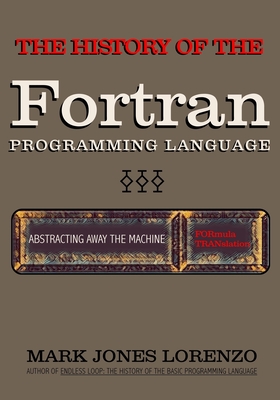Abstracting Away the Machine: The History of the FORTRAN Programming Language (FORmula TRANslation)

Abstracting Away the Machine: The History of the FORTRAN Programming Language (FORmula TRANslation)
At the dawn of the computer age, an elite development team at IBM built the most influential computer programming language in history: FORTRAN. Abstracting Away the Machine tells the epic story of how they did it--and what happened next.
Over the past six decades, programming languages like ALGOL, BASIC, C/C++, COBOL, Java, LISP, LOGO, Pascal, PL/I, Python, Visual Basic, and many others opened up the field of computer science, and of computer programming in general, to the masses. But all of these high-level languages (HLLs)--computer languages that automate, hide, or otherwise abstract away the underlying operations of the machine--owe a huge debt of gratitude to FORTRAN (FORmula TRANslation), the first HLL to achieve widespread adoption.
Many programming practices that we take for granted now came about as a result of FORTRAN. Created over a three-year period at IBM by a development team led by a brilliant but wayward mathematician named John W. Backus, FORTRAN was implemented initially on the IBM 704 mainframe computer in the mid-1950s, with dialects of the language quickly spreading thereafter to other platforms.
FORTRAN's powerful compiler, which translated human-readable code into code a computer could understand, produced incredibly clean and optimized standalone executable programs, all of which could be run independently of the compiler, setting the standard for decades to come--and overcoming the doubts of many skeptics along the way, who thought the FORTRAN project would never succeed. In the 1960s the language was standardized, with machine-dependent commands excised, and many platform-independent implementations followed. With the language now portable, able to run on any computer (at least in theory), FORTRAN, almost by accident, secured a stranglehold in the fields of science and engineering. The language also came to dominate in the supercomputing industry.
But FORTRAN, a blue-collar workhorse more concerned with results than with style, was a victim of its own success--the language sowed the seeds of its own demise. New high-level languages sprouted up, stealing the good bits from FORTRAN while simultaneously defining themselves in opposition to it. FORTRAN had become the foil. As these new languages pierced the cutting edge of the programming landscape, they redefined computing paradigms (e.g., with structured programming, object-oriented programming, and the like), and FORTRAN--though eventually (and repeatedly) modern
PRP: 127.88 Lei
Acesta este Prețul Recomandat de Producător. Prețul de vânzare al produsului este afișat mai jos.
102.30Lei
102.30Lei
127.88 LeiLivrare in 2-4 saptamani
Descrierea produsului
At the dawn of the computer age, an elite development team at IBM built the most influential computer programming language in history: FORTRAN. Abstracting Away the Machine tells the epic story of how they did it--and what happened next.
Over the past six decades, programming languages like ALGOL, BASIC, C/C++, COBOL, Java, LISP, LOGO, Pascal, PL/I, Python, Visual Basic, and many others opened up the field of computer science, and of computer programming in general, to the masses. But all of these high-level languages (HLLs)--computer languages that automate, hide, or otherwise abstract away the underlying operations of the machine--owe a huge debt of gratitude to FORTRAN (FORmula TRANslation), the first HLL to achieve widespread adoption.
Many programming practices that we take for granted now came about as a result of FORTRAN. Created over a three-year period at IBM by a development team led by a brilliant but wayward mathematician named John W. Backus, FORTRAN was implemented initially on the IBM 704 mainframe computer in the mid-1950s, with dialects of the language quickly spreading thereafter to other platforms.
FORTRAN's powerful compiler, which translated human-readable code into code a computer could understand, produced incredibly clean and optimized standalone executable programs, all of which could be run independently of the compiler, setting the standard for decades to come--and overcoming the doubts of many skeptics along the way, who thought the FORTRAN project would never succeed. In the 1960s the language was standardized, with machine-dependent commands excised, and many platform-independent implementations followed. With the language now portable, able to run on any computer (at least in theory), FORTRAN, almost by accident, secured a stranglehold in the fields of science and engineering. The language also came to dominate in the supercomputing industry.
But FORTRAN, a blue-collar workhorse more concerned with results than with style, was a victim of its own success--the language sowed the seeds of its own demise. New high-level languages sprouted up, stealing the good bits from FORTRAN while simultaneously defining themselves in opposition to it. FORTRAN had become the foil. As these new languages pierced the cutting edge of the programming landscape, they redefined computing paradigms (e.g., with structured programming, object-oriented programming, and the like), and FORTRAN--though eventually (and repeatedly) modern
Detaliile produsului










